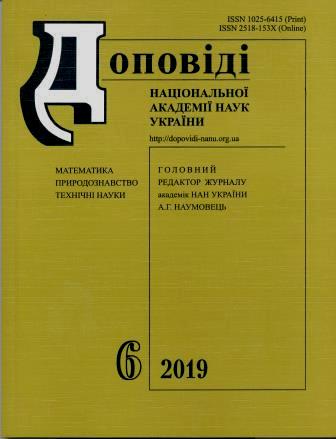Адсорбція барвників різної природи на пористих сорбентах на основі полівінілформалю
DOI:
https://doi.org/10.15407/dopovidi2019.06.054Ключові слова:
барвники, полівінілформаль, полімер губчатий, сорбціяАнотація
Синтезовано високопористий губчатий полімер на основі полівінілформалю (ПВФ), а також наповнені композитні сорбенти на його основі з добавками вуглецевих нанотрубок, лапоніту та амінопропілаеросилу. Вивчено закономірності сорбції барвників різної природи (катіонного — метиловий фіолетовий, аніонного — азо рубін та неіоногенного — нігрозин) на отриманих сорбентах. Встановлено залежність степеня сорбції барвників від рН розчину: азорубін вилучається при рН < 4, а метиловий фіолетовий при рН > 4. Час досягнення адсорбційної рівноваги для усіх сорбентів при сорбції барвників становить 15—30 хв. Найвищу сорбційну ємність щодо азорубіну та нігрозину має ПВФ, наповнений амінопропілаеросилом (11,4 та 7,1 мг/г відповідно), а метилового фіолетового — ненаповнений ПВФ (5,0 мг/г). Кінетика адсорбції описується моделлю псевдодругого порядку. Для опису адсорбції метилового фіолетового на усіх сорбентах найкраще підходить теоретична модель ізотерм Ленгмюра, а у випадку нігрозину — модель Фрейндліха. Моделі Ленгмюра також краще підпорядковується адсорбція азорубіну на чистому ПВФ та ПВФ, наповненому амінопропілаеросилом, моделі Фрейндліха — на ПФВ, наповнених вуглецевими нанотрубками та лапонітом.
Завантаження
Посилання
Yagub, M. T., Sen, T. K., Afroze, S. & Ang, H. M. (2014). Dye and its removal from aqueous solution by adsorption: a review. Adv. Colloid Interface Sci., 209, pp. 172-184. doi: https://doi.org/10.1016/j.cis.2014.04.002
Ptaszkowska-Koniarz, M., Goscianska, J. & Pietrzak, R. (2017). Adsorption of dyes on the polymer nanocomposites modified with methylamine and copper(II) chloride. J. Colloid Interface Sci., 504, pp. 549-560. doi: https://doi.org/10.1016/j.jcis.2017.06.008
Sandeman, S. R., Gun’ko, V. M., Bakalinska, O. M., Howell, C. A., Zheng, Y., Kartel, M. T., Phillips, G. J. & Mikhalovsky, S. V. (2011). Adsorption of anionic and cationic dyes by activated carbons, PVA hydrogels, and PVA/AC composite. J. Colloid Interface Sci., 358, pp. 582-592. doi: https://doi.org/10.1016/j.jcis.2011.02.031
Li, P., Siddaramaiah, Kim, N. H., Yoo, G.-H. & Lee, J.-H. (2009). Poly(acrylamide/laponite) nanocomposite hydrogels: swelling and cationic dye adsorption properties. J. Appl. Polym. Sci., 111, pp. 1786-1798. doi: https://doi.org/10.1002/app.29061
Samchenko, Yu., Korotych, O., Kernosenko, L., Kryklia, S., Litsis, O., Skoryk, M., Poltoratska, T. & Pasmurtseva, N. (2018). Stimuli-responsive hybrid polymers based on acetals of polyvinyl alcohol and acrylic hydrogels. Colloids Surf. A, 544, pp. 91-104. doi: https://doi.org/10.1016/j.colsurfa.2018.02.015
Kryklya, S., Samchenko, Yu., Konovalova, V., Poltoracka, T., Pasmurceva, N. & Ulberg, Z. (2016). Hybrid pHand thermosensitive hydrogels based on polyvinylalcohol and acrylic monomers. Magisterium. Iss. 63, Chemical sciences, pp. 20-28 (in Ukrainian).
Dawodu, M. O., Akpomie, K. G. (2016). Evaluation of potential of a Nigerian soil as an adsorbent for tartrazine dye: Isotherm, kinetic and thermodynamic studies. Alexandria Eng. J., 55, pp. 3211-3218. doi: https://doi.org/10.1016/j.aej.2016.08.008
##submission.downloads##
Опубліковано
Як цитувати
Номер
Розділ
Ліцензія
Авторське право (c) 2024 Доповіді Національної академії наук України

Ця робота ліцензується відповідно до Creative Commons Attribution-NonCommercial 4.0 International License.




